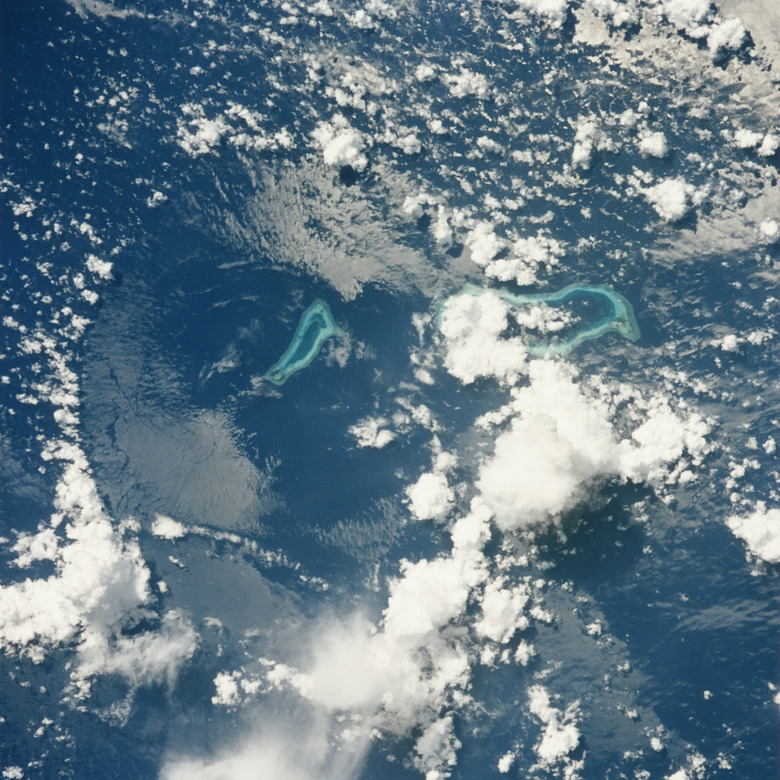What Layer Of The Atmosphere Is Of The Greatest Interest To Meteorologists?
The troposphere is the layer of Earth's atmosphere that meteorologists watch most closely because it's where weather happens. Of all the layers that form the atmosphere, it's the closest to the ground, and all of Earth's landforms, including the highest mountains, exist within it. The troposphere contains 75 percent of the Earth's atmospheric gases, including 99 percent of its water vapor, which plays a major role in regulating the temperature on the surface of the planet.
Five Atmospheric Layers
Five Atmospheric Layers
The envelope of gases that surrounds the Earth and extends almost halfway to the moon consists of five discrete layers. The troposphere extends to a distance of 14 to 18 kilometers (8.6 to 11.2 miles) above the ground and merges into the tropopause, a buffer between that layer and the next, which is the stratosphere. The mesosphere begins at an altitude of approximately 90 kilometers (56 miles), just above the thin layer of ozone in the upper stratosphere that blocks ultraviolet sunlight. Auroras occur in the next layer, which is known as the ionosphere, or thermosphere, and finally the exosphere gradually thins and merges with empty space.
Composition of the Troposphere
Composition of the Troposphere
Besides nitrogen, oxygen and argon, trace amounts of several other gases exist in the troposphere, and two of them — water vapor and carbon dioxide — are especially important for meteorologists. Both absorb and reflect heat from the ground that would otherwise radiate into space, thus keeping the surface of the planet warm enough to support life. The concentration of water vapor isn't constant — it increases with increasing latitude, forming about 3 percent of the troposphere at the equator. Besides these two greenhouse gases, the troposphere also consists of fluctuating amounts of pollutants, such as sulfur dioxide and ozone, especially near large cities.
Sun and Wind
Sun and Wind
The tropospheric winds that carry heat and moisture around the globe are fueled by the sun's energy. The sun heats the equator more than it does the poles, and the temperature differential causes a movement of air that is deflected by the rotation of the Earth. This causes winds to move in a easterly winds in the equatorial and polar regions and westerly winds in the middle latitudes. High and low pressure areas, as well as local patterns of turbulence, interact with these global winds to produce the changing wind patterns that meteorologists study.
The Water Cycle
The Water Cycle
The movement of water among the gas, liquid and solid states that is fueled by the uneven heating of the Earth's surface by the sun is another important weather dynamic. Water vapor, present in the air because of evaporation from the oceans and plant transpiration, cools as it rises to form clouds, and within the clouds, water condenses and freezes to fall back to the surface as rain and snow. Only the largest clouds, typically formed as part of a hurricane, reach into the stratosphere. Most form entirely within the troposphere.
Cite This Article
MLA
Deziel, Chris. "What Layer Of The Atmosphere Is Of The Greatest Interest To Meteorologists?" sciencing.com, https://www.sciencing.com/layer-atmosphere-greatest-interest-meteorologists-10406/. 24 April 2017.
APA
Deziel, Chris. (2017, April 24). What Layer Of The Atmosphere Is Of The Greatest Interest To Meteorologists?. sciencing.com. Retrieved from https://www.sciencing.com/layer-atmosphere-greatest-interest-meteorologists-10406/
Chicago
Deziel, Chris. What Layer Of The Atmosphere Is Of The Greatest Interest To Meteorologists? last modified August 30, 2022. https://www.sciencing.com/layer-atmosphere-greatest-interest-meteorologists-10406/
